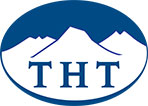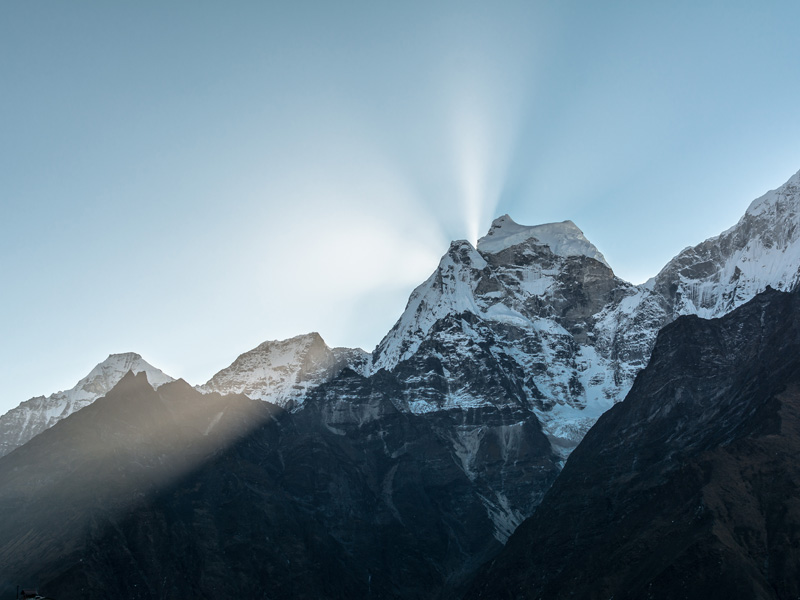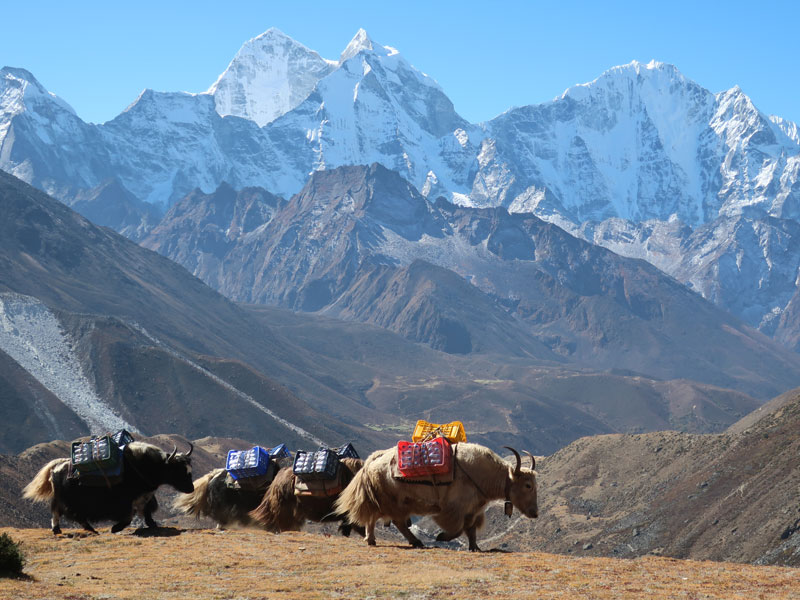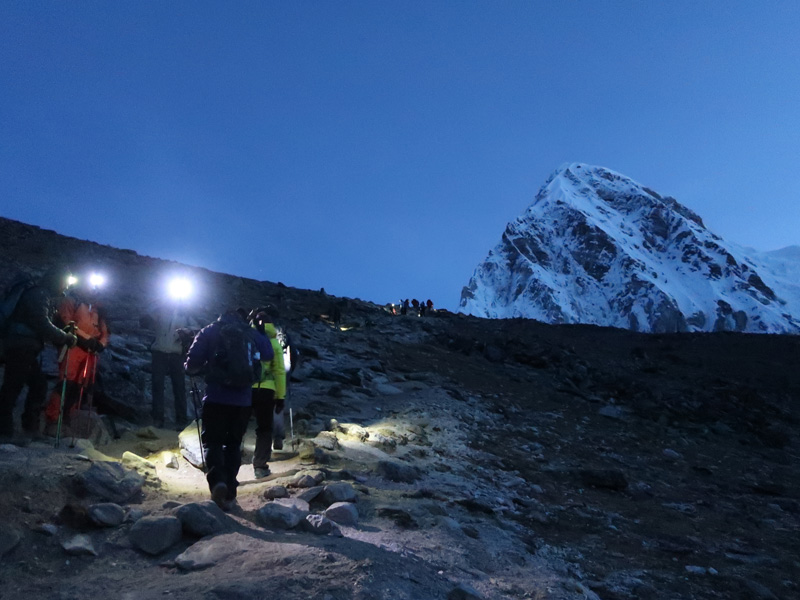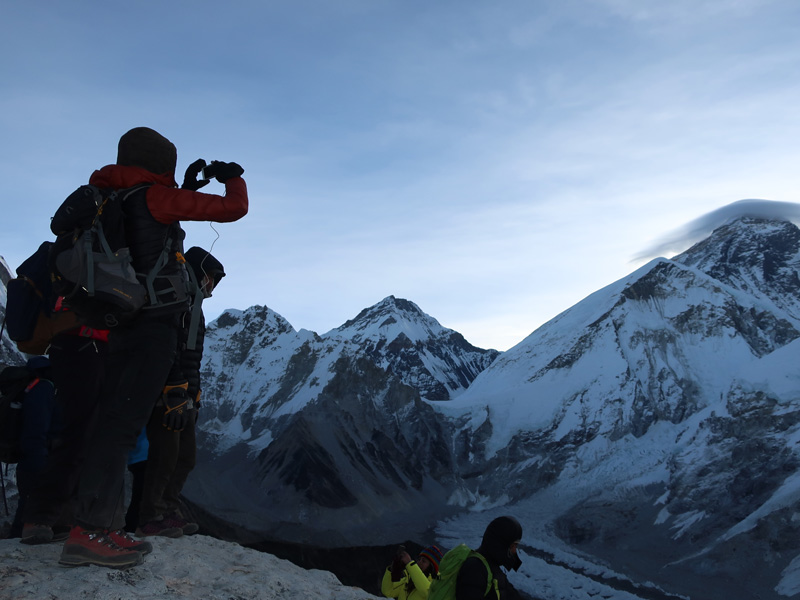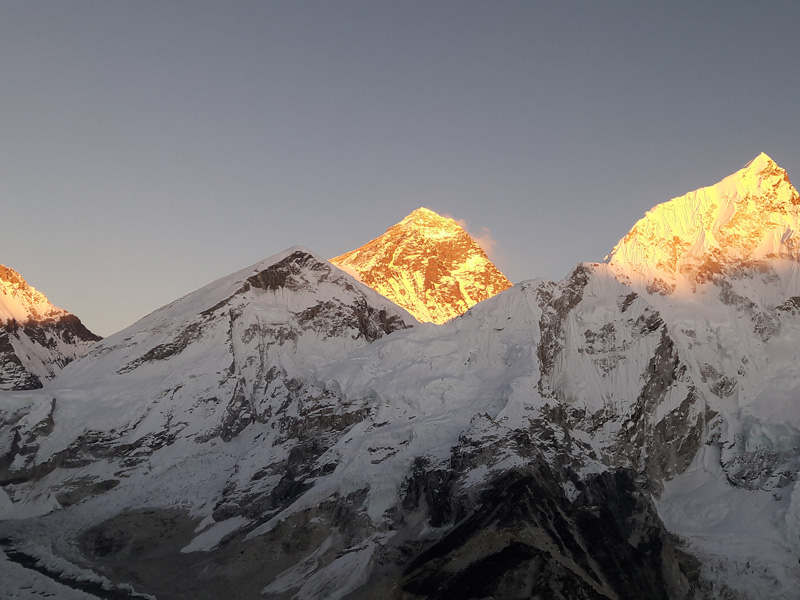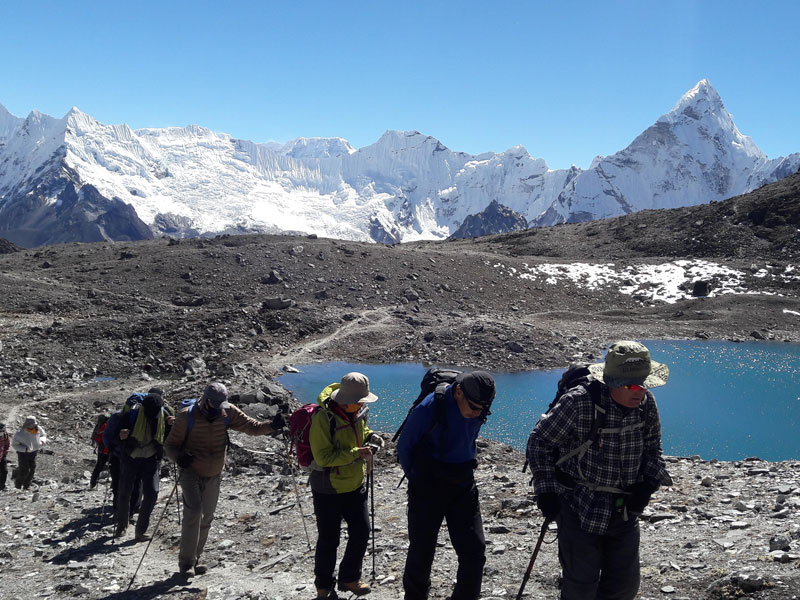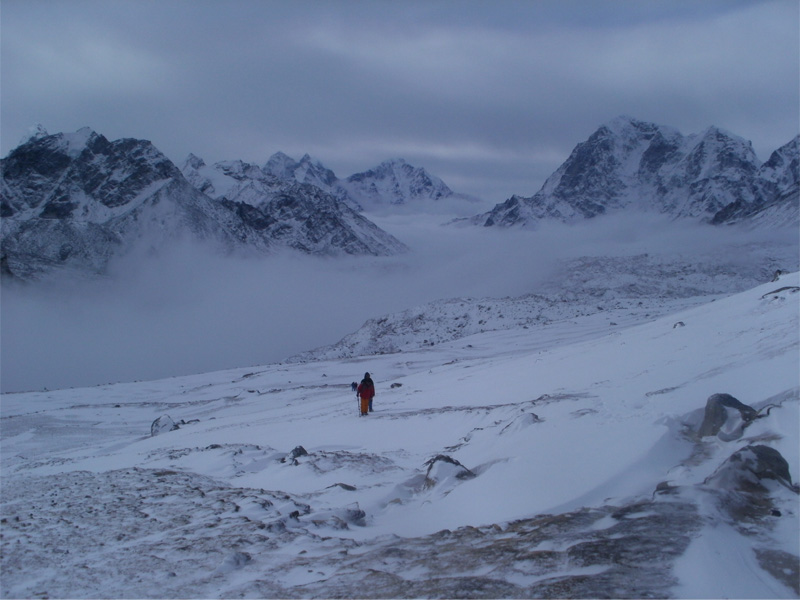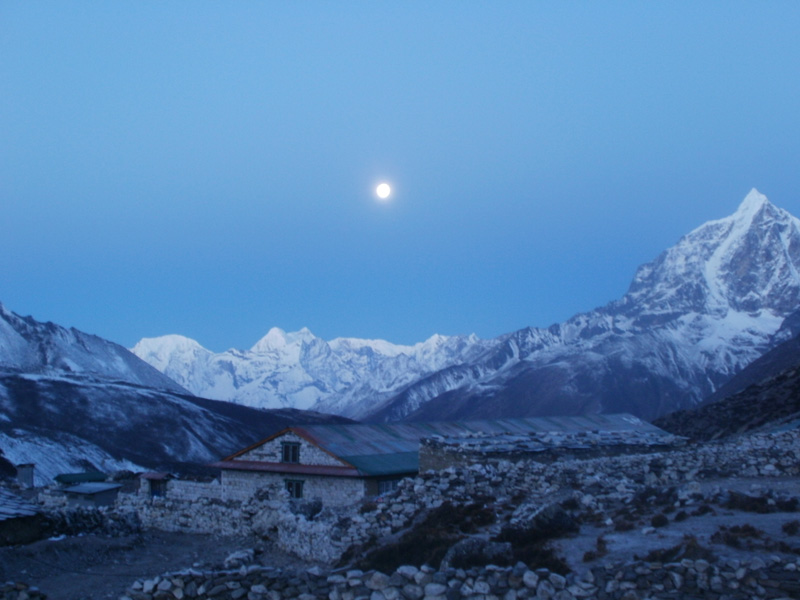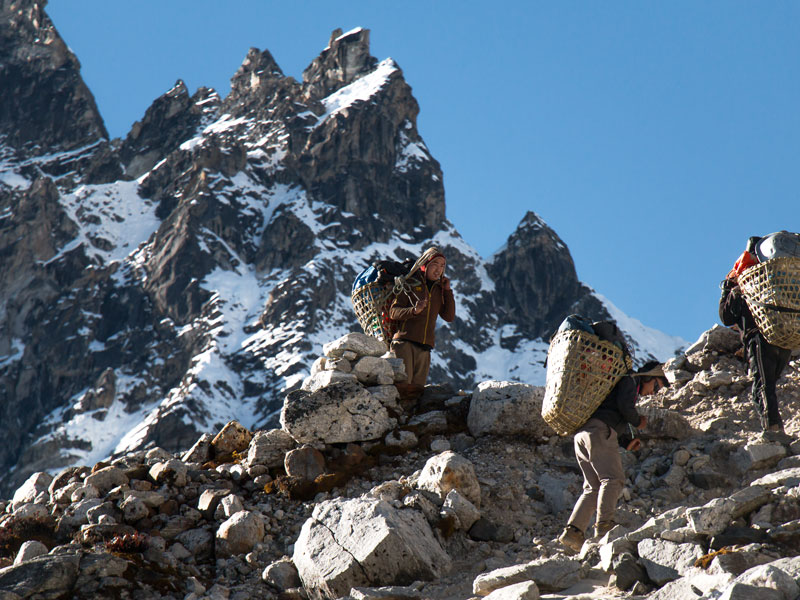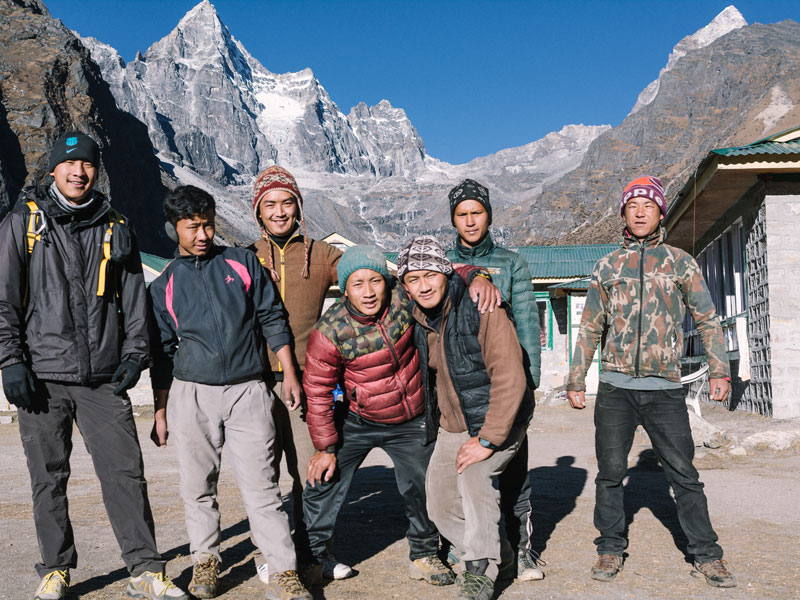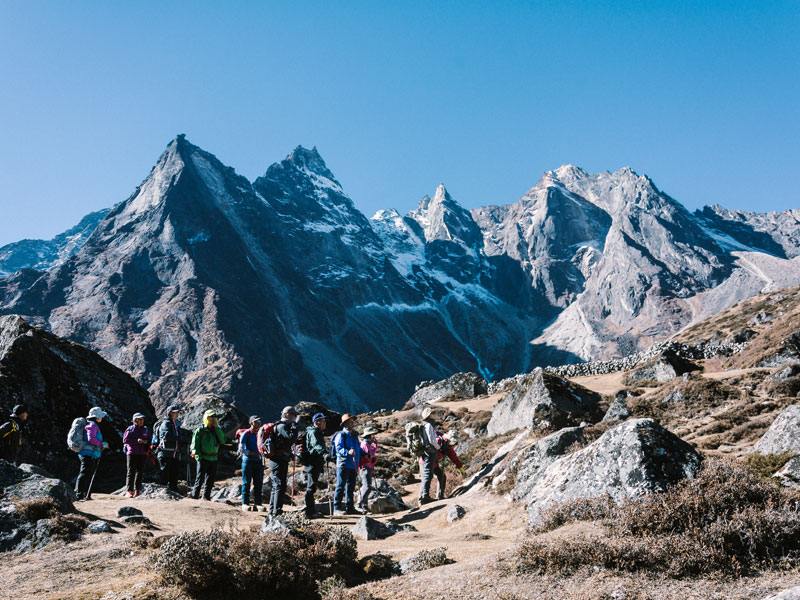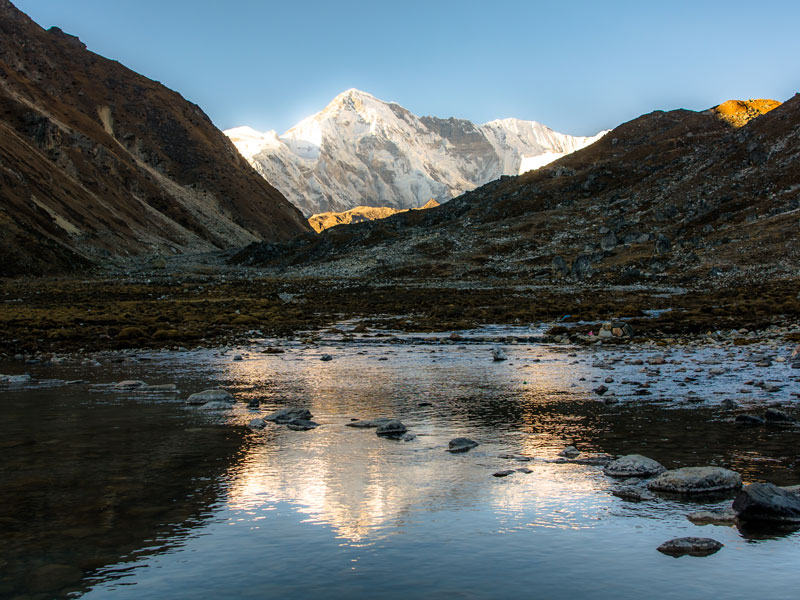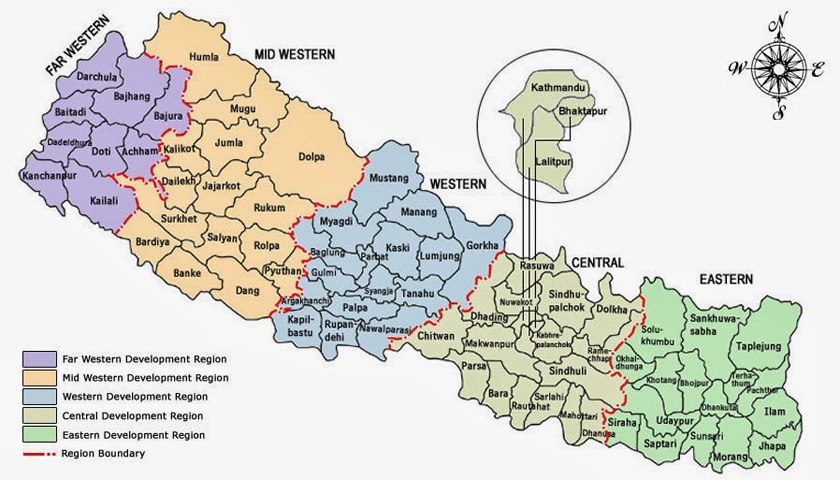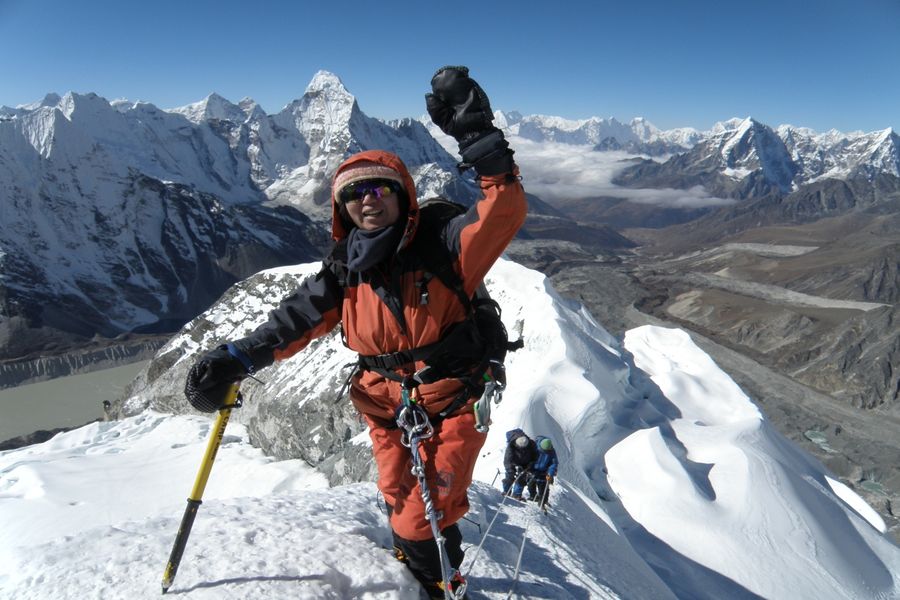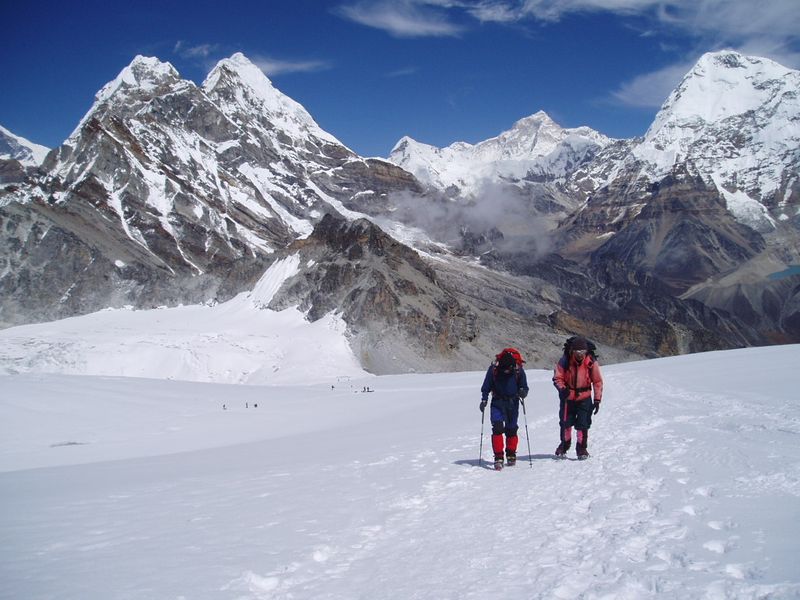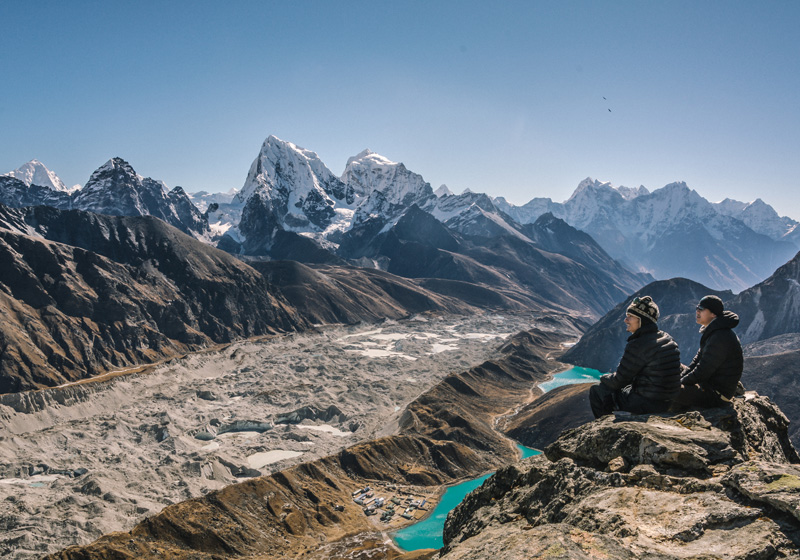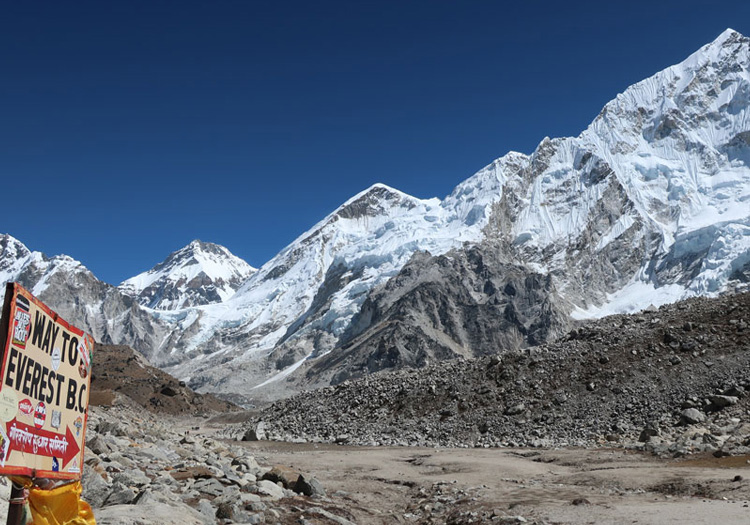Trans Himalayan Tour (P) Ltd.
Over 50 years of Delivering Himalayan Adventures
Classic Three Pass Three Peak Trek - 21 Days
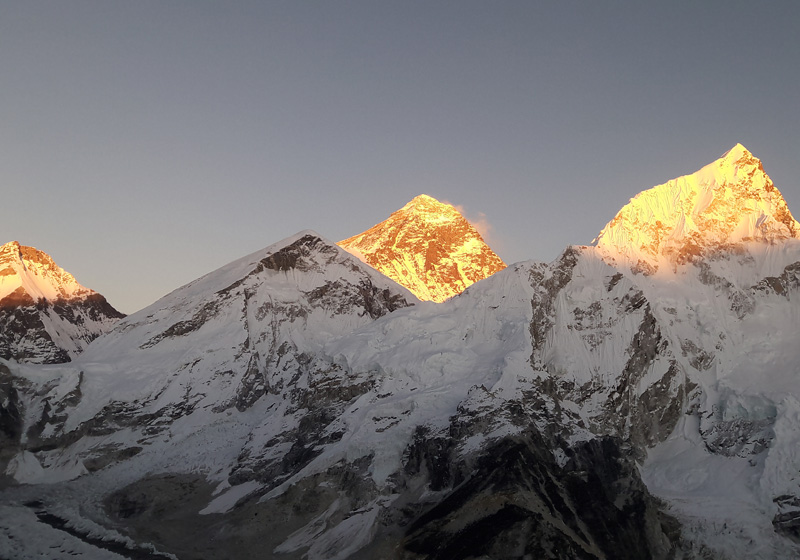
Trip facts
This epic trek around the Everest region goes over some of the highest mountain passes in the world, combining the highlights of Everest Base Camp and Gokyo treks along with breathtaking views from Kala Patthar, Gokyo Ri and Chukkung Ri peaks. This trek is best suited for experienced trekkers and although crossing the three passes is not technically difficult, you do need a strong mindset and grit to successfully complete this challenging trek. We have laid out the itinerary so that it is more practical in terms of the hours taken and the overnight stops. You would be well acclimatized for the high altitudes and enjoy the pace of the trek so that you have enough time to really soak in the experience. You will be passing through beautiful valleys, pristine lakes, the longest glacier in the Himalayas and learn to appreciate the difficult terrain and friendly local cultures.
Crossing the rugged high passes of Kongma La (5535m), Cho La (5420m), Renjo la (5345m), along with climbing of the three peaks of Kalapathar (5545m), Chukung Ri (5546m) and Gokyo Ri (5357m), makes the three pass three peak trek the ultimate trekking experience in the Everest region.
For those visiting during the peak season (March 15th – May 15th and Oct 1th – Dec 5th), it may be possible to take a helicopter shuttle from HEV to Lukla instead of trekking back.
BRIEF DETAILS
DAY 01:
International Arrival in Kathmandu
DAY 02:
Kathmandu to Lukla to Phakding: 35min flight, 3-4 hrs trek. Ending Elevation: 2610m
DAY 03:
Phakding to Namche Bazaar: 6-7 hrs. Ending Elevation: 3440m
DAY 04:
Acclimatization Day in Namche Bazaar
DAY 05:
Namche to Tengboche/Debuche: 5hrs. Ending Elevation: 3860m
DAY 06:
Debuche to Dingboche: 5-6 hrs. Ending Elevation: 4410m
DAY 07:
Acclimatization at Dingboche
DAY 08:
Dingboche to Chhukung: 3-4 hrs. Ending Elevation 4750m
DAY 09:
Chhukung to Kongma La pass (5535m), trek to Lobuche: 9 hours. Ending Elevation 4930m
DAY 10:
Lobuche to Gorakshep: 3 hrs hike. Gorakshep to Everest Base Camp (5364m) round trip: 4-5 hrs. Ending Elevation: 5160m
DAY 11:
Gorakshep to Kala Pathar (5545m) and then to Dzonglha: 7-8 hours. Ending Elevation: 4830m.
DAY 12:
Dzonglha - Cho La Pass (5420m) – Tagnak: 8-9 hrs. Ending Elevation 4700m
DAY 13:
Tagnak to Gokyo: 3-4hrs, Ending Elevation: 4750m
DAY 14:
Gokyo to Gokyo Ri: 4-5 hrs. Highest Elevation: 5357m
DAY 15:
Gokyo to Lungden via Renjo La Pass (5360m): 7 - 8 hours. Ending Elevation: 4210m
Day 16:
Lungden to Thamo: 5 - 6 hours. Ending Elevation: 3480m
DAY 17:
Thamo to Hotel Everest View: 3.5-4 hours. Ending Elevation: 3880m
DAY 18:
HEV to Phakding: 5-6 hrs. Ending Elevation: 2610m
DAY 19:
Phakding to Lukla: 3-4 hrs. Ending Elevation: 2860m
DAY 20:
Lukla to Kathmandu
DAY 21:
International Departure
INCLUDED IN COST
 International & domestic airport pick up and drop off to and from a hotel in Kathmandu
International & domestic airport pick up and drop off to and from a hotel in Kathmandu
 Overnights in Kathmandu on BB (bed & breakfast) basis in a 4/5 star category hotel
Overnights in Kathmandu on BB (bed & breakfast) basis in a 4/5 star category hotel
 Domestic flights and ground transportation
Domestic flights and ground transportation
 Government licensed main trekking guide, assistant guide (for groups over 3 pax) and porters. One porter for every two trekkers.
Government licensed main trekking guide, assistant guide (for groups over 3 pax) and porters. One porter for every two trekkers.
 Staff costs are included – wages, insurance, equipment, food & accommodation
Staff costs are included – wages, insurance, equipment, food & accommodation
 Trekking accommodation in tea houses with attached bathrooms where available
Trekking accommodation in tea houses with attached bathrooms where available
 3 meals a day including breakfast, lunch, and dinner plus tea/coffee breaks during the trek
3 meals a day including breakfast, lunch, and dinner plus tea/coffee breaks during the trek
 A 60 liter company duffel bag per person – for yours to keep
A 60 liter company duffel bag per person – for yours to keep
 Sleeping bags (good up to -20 degrees) and hot water bags for the duration of the trek
Sleeping bags (good up to -20 degrees) and hot water bags for the duration of the trek
 First Aid kit – to be carried by the trekking guide
First Aid kit – to be carried by the trekking guide
 Trekking permits and entrance fees
Trekking permits and entrance fees
 Kathmandu valley sight-seeing tour with private vehicle and city guide as mentioned in itinerary
Kathmandu valley sight-seeing tour with private vehicle and city guide as mentioned in itinerary
 All rates are inclusive of service charge and government tax
All rates are inclusive of service charge and government tax
BRIEF DETAILS
DAY 01:
International Arrival in Kathmandu
DAY 02:
Kathmandu to Lukla to Phakding: 35min flight, 3-4 hrs trek. Ending Elevation: 2610m
DAY 03:
Phakding to Namche Bazaar: 6-7 hrs. Ending Elevation: 3440m
DAY 04:
Acclimatization Day in Namche Bazaar
DAY 05:
Namche to Tengboche/Debuche: 5hrs. Ending Elevation: 3860m
DAY 06:
Debuche to Dingboche: 5-6 hrs. Ending Elevation: 4410m
DAY 07:
Acclimatization at Dingboche
DAY 08:
Dingboche to Chhukung: 3-4 hrs. Ending Elevation 4750m
DAY 09:
Chhukung to Kongma La pass (5535m), trek to Lobuche: 9 hours. Ending Elevation 4930m
DAY 10:
Lobuche to Gorakshep: 3 hrs hike. Gorakshep to Everest Base Camp (5364m) round trip: 4-5 hrs. Ending Elevation: 5160m
DAY 11:
Gorakshep to Kala Pathar (5545m) and then to Dzonglha: 7-8 hours. Ending Elevation: 4830m.
DAY 12:
Dzonglha - Cho La Pass (5420m) – Tagnak: 8-9 hrs. Ending Elevation 4700m
DAY 13:
Tagnak to Gokyo: 3-4hrs, Ending Elevation: 4750m
DAY 14:
Gokyo to Gokyo Ri: 4-5 hrs. Highest Elevation: 5357m
DAY 15:
Gokyo to Lungden via Renjo La Pass (5360m): 7 - 8 hours. Ending Elevation: 4210m
Day 16:
Lungden to Thamo: 5 - 6 hours. Ending Elevation: 3480m
DAY 17:
Thamo to Hotel Everest View: 3.5-4 hours. Ending Elevation: 3880m
DAY 18:
HEV to Phakding: 5-6 hrs. Ending Elevation: 2610m
DAY 19:
Phakding to Lukla: 3-4 hrs. Ending Elevation: 2860m
DAY 20:
Lukla to Kathmandu
DAY 21:
International Departure
Day 01 | International arrival in Tribhuvan Airport, Kathmandu
Welcome to Nepal! A representative from Trans Himalayan Tour will pick you up from the airport and take you to your hotel in Kathmandu. We will have booked a 4 star/5 star accommodation for you, depending on your preference. We would also arrange for your visit to Trans Himalayan Tour office in Patan where we will brief you on the itinerary in person and introduce you to your trekking guide. Overnight in Kathmandu.
Day 02 | Fly from Kathmandu to Lukla, trek to Phakding: 35min flight, 3-4 hrs trek. Ending Elevation: 2610m
The flight into Lukla is spectacular and the airport is situated amongst the hills at an altitude of 2860m. The landing at Lukla airport is an exhilarating beginning to the trek, with the runway being 520m long and 30m wide, along with an incline of 12 degrees.
Once in Lukla, the entry point of the Khumbu valley, you will be meeting your team of guide(s) and porter(s). While you are having breakfast at a local lodge and preparing for the first day of trekking, they will be arranging the luggage to carry. Today you will head through pine and cedar woods in a dusty track studded with rocks along the Dudh Kosi river to Phakding. You pass locals going about their daily chores and you learn to go around Mani stones and cross the suspension bridges. You will also begin to gaze upon the trip’s first mountainous glory, such as the Kusum Kanguru (6367m). It is a gentle start to the Everest region trek and the night will be spent in a comfortable lodge in Phakding village.
Day 03 | Phakding to Namche Bazaar: 6-7 hrs. Ending Elevation: 3440m
The trek through the lower Khumbu valley is fairly well populated with not too extreme temperatures. The paths lead you through rhododendron and magnolia forests, and past several villages such as Chumoa and Monjo. If you visit during spring season, you might be surprised to see some cherry blossom trees along the way, especially one brought from Japan and planted by a Japanese trekker named Mr. Osawa in Chumoa. Mr. Osawa is no longer with us but he trekked with Trans Himalayan Tour every year for 20 years to go to Gokyo and Gorakshep and take an ice bath in a small lake in Gorakshep.
You will be entering the Sagarmatha (Everest) National Park from Monjo as you dwell deeper into the Khumbu region. It is a strenuous hike uphill from Jorsale to Namche Bazaar with no settlements in between. The first glimpse of Mt. Everest (8848m), Lhotse (8516m) and Nuptse (7861m) can be seen from Toap Hill which is a good place for a break. Go slowly while you ascend and notable mountains include the Kongde Ri (6187m), Kusum Kang (6367m) and Thamserku (6608m).
Day 04 | Acclimatization Day in Namche Bazaar
Namche Bazaar is regarded as the ‘capital’ of the Khumbu region and the gateway to the high Himalayan treks. The village has many colorful shops and lodges where it is possible to find almost anything required for trekking. An acclimatization day is scheduled to adjust your body to the change in altitude and help avoid symptoms of Acute Mountain Sickness (AMS) in higher elevation. It is recommended to take hikes to nearby side trips such as to Hotel Everest View in Syangboche or the Sherpa villages of Khumjung and Khunde.
Day 05 | Namche Bazaar to Tengboche/Debuche: 5hrs. Ending Elevation: 3860m
The view from the popular Tengboche Monastery is deemed to be absolutely amazing. The monastery is located within the Sagarmatha National Park and provides panoramic views of the highest mountains on earth with views of Ama Dablam (6856m), Kangtega (6685m), Everest (8848m), and Taboche (6542m) all appearing in close proximity. If you reach Tengboche village by 3pm, you may be able to observe the Buddhist chanting ceremony by resident monks at the monastery. As the lodges in Tengboche can be easily packed, you have the option of going further to Debuche, which lies 20 minutes ahead for your overnight stay.
Day 06 | Tengboche to Dingboche: 5-6 hrs. Ending Elevation: 4410m
The route to Dingboche would mostly be on level grounds. You move through the green and moss covered trees with glacial streams raging below. You would cross the Imja river on a steel bridge and the backdrop of Ama Dablam makes it a great Kodak moment. Pangboche would be the last forested area that you will see until your descend from Everest Base Camp. Today would be the day that you trek above the tree line and move into a completely different type of landscape all together, with plant life limited to small shrubs and grasses. The view of Lhotse, Nuptse, Island Peak, Peak 38, Tabuche, Cholatse, Ama Dablam, Kantega and Thamserku comes fully in sight during the duration of the trek.
Day 07 | Acclimatization at Dingboche
For the rest day at Dingboche, you can chose to go to Mt. Makalu (8463m) viewpoint in the morning or take the day to visit Chhukung which is further away. The viewpoint will reward you with panoramic views of Makalu (8463m), Lhotse (8516m), Cho Oyu (8201m), Thamserku (6608m) and Kantega (6782m) to name a few. Chhukung is a scenic village surrounded by mountains and this makes for a challenging but highly rewarding acclimatization hike. From here on, the winds cut through like ice so please make sure that you wear proper layers and have a strong windproof jacket and cover your ears.
An interesting fact about Dingboche is that there are no residents here during the monsoon season after the plantation of crops. The lodges are not allowed to produce smoke in fear that it may disturb the crops and residents move out to higher or lower elevation for these months. It is a tradition that is carried on even today. If you were to do the EBC trek during monsoon, you would be staying at Pheriche instead of Dingboche.
Day 08 | Dingboche to Chhukung: 3-4 hrs. Chhukung to Chhuking Ri (5546m): 5-6 hrs round trip. Ending Elevation 4750m
You are recommended to stay one night at Chukkung before attempting the Kongma La Pass. The trek to the village from Dingboche is around 3-4 hours. If you are up for a challenge, you can take a hike to Chhukung Ri (5546m), from where you will be rewarded with amazing views of Ama Dablam, Baruntse and Makalu. The peak of Chhukung lies at the head of the Imja Valley, towering over Chhukung village, which itself has wonderful mountain views. At the peak you will find yourself surrounded by the Himalayas and the glaciers on all sides.
Day 09 | Chhukung to Kongma La pass (5535m), trek to Lobuche: 9 hours. Ending Elevation 4930m
On this day you head from Chhukung to Lobuche over the Kongma La pass. It is recommended to start the trek very early as it is going to be a long day. There are no tea shops along the way, you need to be sure to carry enough water and food supply to last until you reach Lobuche. On the first stage of the trek, there are admirable views back across the valley to Island Peak. The next few hours would be trekking through trails scattered with boulders and climbing over several cliffs until you reach a wide basin dotted with small frozen lakes. Right above the basin is Kongma La Pass (5535), the highest pass of the three passes, decorated with Buddhist prayer flags. The descent down to Lobuche is a long and tough journey and you would be walking north of the Khumbu Glacier until you reach Lobuche.
Day 10 | Lobuche to Gorakshep | Lobuche to Gorakshep: 3 hrs hike. Gorakshep to Everest Base Camp (5364m) round trip: 4-5 hrs. Ending Elevation: 5160m
The trail begins from a narrow gap between the glacial moraine and the mountain and within a few hours you will arrive at the sandy, flat area on which the lodges in Gorakshep are situated. The lodges here are very basic and sleeping at over 5000m is seldom comfortable, however it is a convenient stop for trekkers wanting to get to EBC and Kala Pathar.
After dropping your duffel bag in the lodge room at Gorakshep and having lunch, you can prepare yourself to realize your dream of reaching Everest Base Camp. The round trip hike takes around 4-5 hours and it is a grueling walk involving going over glacial moraine and rocks with strong winds. Be sure to look out to the Khumbu Glacier and the Khumbu Icefall located on the slopes of the mighty Everest. While at Base Camp, take a moment to soak in the experience of what you have accomplished. If you happen to be there around expedition season, you will see dozens of colorful tents filled with different nationalities, all eager to climb to the highest point on earth.
Day 11 | Gorakshep to Kala Pathar (5545m) and then to Dzonglha: 7-8 hours. Ending Elevation: 4830m
The hike to Kala Pathar involves an early morning rise and a determination to walk up a steep trail for one of the best views of Mt. Everest. After a 200m ascent to the summit, enjoy the glorious views of the Himalayas and the mighty Everest up close. The steep hike to Kala Patthar starts early in the morning with headlights and at the top, the sun rises from behind Mt. Everest. The south face of Everest becomes clear as well as Pumori, Lobuche West, Nuptse, Lhotse and other magnificent peaks all around.
Going to Kala Pathar is optional, as you may want to head straight to Dzongla to prepare for Cho La Pass the next day. Follow the Lobuche Khola downstream curving through the wide river bed where, after a while, you can take a trail to the right heading off towards Dzonghla.
Day 12 | Dzonglha to Tagnak via Cho La Pass (5420m): 8-9hrs. Ending Elevation 4700m
Today is going to be one of the toughest days of the trip, starting from early morning. You will be rewarded with the dramatic landscape of walking nearby the snow covered peaks, with a perfect frame of Ama Dablam to the south and Cholatse rising to the west. The Cho La Pass involves a steep, vertical ascent and the paths glazed by ice and loose stones may make the trail slippery. It is therefore better to start very early before the sun starts to melt the ice. It is recommended to take crampons (even simple portable ones) for better support.
You will know when you have reached Cho La Pass with the sight of the customary prayer flags fluttering in the wind. The trail will then lead you through the side of a frozen lake, down towards a rocky trail along a ravine. It is the Cho La Pass that links the Everest Base Camp and Gokyo treks. As there are no facilities between Dzoglha and Tagnak, you would need to carry your supply of water and snacks for the day.
Instead of going directly to Gokyo after crossing Cho La Pass but we will stay in Tagnak for the night as it has been a long day and we would not want anyone crossing the glacier moraine after dark to get to Gokyo.
Day 13 | Tagnak to Gokyo: 3-4 hrs, Ending Elevation 4750m
Trekking down towards the Gokyo valley and crossing the Ngozumpa Glacier, which is the longest glacier in the Himalayas, today you will reach the beautiful village of Gokyo where you can sit back, relax and soak in the magical views of the turquoise blue lakes. The village of Gokyo stands by the third lake (Dudh Pokhari) and provides panoramic views of Taboche, Cholatse, Machhermo peak, Renjo La and Cho Oyu.
Day 14 | Gokyo to Gokyo Ri: 4-5 hrs. Highest Elevation 5357m
Gokyo Ri is a 5357m high peak in the Khumbu region of the Nepal Himalayas, amongst the Gokyo lakes. It is located on the west side of the Ngozumpa glacier. At the top of the peak you are provided with a front row seat to the Himalayan amphitheater with a 360 degree views of the mountains and the Ngozumpa Glacier. Your gaze will scroll through clockwise going from Cho Oyo, Nuptse, Everest, Lhotse Shar, Makalu, Cholatse, Tabuche, Kantega, Thamserku, Lobuche and countless other peaks with the turquoise lakes seated serenely below. Overnight in Gokyo.
Day 15 | Gokyo to Lungden via Renjo La Pass (5360m): 7 - 8 hours. Ending Elevation: 4210m
It is good fun to map out the route to Renjo pass from the banks of Dudh Pokhari (the lake), as the path looks incredulous but your guide will be telling you that yes, you will be crossing that ridge. The climb to Renjo Pass can be quite challenging and the right approach is to ascend very slowly as any exertion can leave the climber breathless. After around four hours of leaving Gokyo, you will arrive at the summit of Renjo La Pass (5360m). From the top of the pass you will get to see the mighty peaks of Everest, Lhotse, Cholatse, and Taboche to name a few as well as the lakes enclosed by the Ngozumpa Glacier. Herein lies one of the best (if not the best) views of the Everest region. The descent to Lungden is via a narrow valley strewn with giant boulders. Be sure to have your head and ears protected as the wind picks up on the other side of Renjo Pass.
Day 16 | Lungden to Thamo: 5 - 6 hours. Ending Elevation: 3480m
The high valley around Lungden sees few trekkers and remains the simple domain for yaks and pastures. It is a pleasant downhill today and you walk by some very old, authentic Himalayan villages that blend almost invisibly into the landscape. You will pass by the village of Thame, where the legendary Tenzing Norgay grew up. The monastery there is also one of the oldest in the Khumbu region. While most treks stop for the night at Thame, we will stay overnight in Thamo village. It is another 1.5 hours away but the lodges are much warmer and our trek to Hotel Everest View tomorrow is made closer.
Day 17 | Thamo to Hotel Everest View: 3.5-4 hours. Ending Elevation: 3880m
It is a relatively straight path for half of the trail today and you will be trekking inside a jungle of pine trees until you come out to the Syangboche airstrip. Although this airstrip is no longer used for passenger planes, it was originally constructed to service Hotel Everest View in the early 1970s. Building this airstrip required 1.5 tons of dynamite, a 3 ton bulldozer plus a smaller bulldozer. Almost all the material were carried by porters, only very few items were taken via helicopter from Kathmandu. Syangboche airstrip is now mainly used by the cargo helicopter dropping off goods and as the Everest Sky Diving landing spot.
Opened in 1971, Hotel Everest View has been listed on the Guinness Book of World Records (2004) as the Highest Placed Hotel in the world at 3,880m. Featured in numerous guide books and having received media coverage, the resort has become a destination in its own right. After a highly rewarding Gokyo trek, you may want to simply relax in the comfort of hot showers, electric blankets and some delicious Japanese set menus.
Day 18 | HEV to Phakding: 5-6 hrs. Ending Elevation: 2610m
Trekking from HEV to Phakding, you will be going back the same path you trekked many days ago. This time it is mostly downhill so it may be hard on your weary knees. During the peak seasons in spring and autumn when the helicopter shuttle is available (usually March 15 – May 15 and Oct 1 – Dec 5), you can opt to take the heli from HEV directly to Lukla and fly back to Kathmandu same day, which will save you 2 days of trekking.
Day 19 | Phakding to Lukla: 3-4 hrs. Ending Elevation: 2860m
It is a fairly relaxed trek today and you will be pushing through the final uphill back to Lukla. Enjoy the last day of trekking and celebrate the successful completion of your trek with your guides and porters!
Day 20 | Lukla to Kathmandu
After another short domestic flight from Lukla to Kathmandu, we bring you back to the city that started your journey. The day can be arranged for some sight-seeing around the famous World Heritage sights in Kathmandu, highly recommended are Patan Dubar Square, Boudhanath stupa and Swayambhunath temple (monkey temple). Overnight in Kathmandu.
Day 21 | International Departure
As this epic adventure wraps up, you may already be planning for your next trip to Nepal. A representative from Trans Himalayan Tour will escort you to the international airport in Kathmandu and we wish you a pleasant flight home. All the best until we meet again!
Include:
 International & domestic airport pick up and drop off to and from a hotel in Kathmandu
International & domestic airport pick up and drop off to and from a hotel in Kathmandu
 Overnights in Kathmandu on BB (bed & breakfast) basis in a 4/5 star category hotel
Overnights in Kathmandu on BB (bed & breakfast) basis in a 4/5 star category hotel
 Domestic flights and ground transportation
Domestic flights and ground transportation
 Government licensed main trekking guide, assistant guide (for groups over 3 pax) and porters. One porter for every two trekkers.
Government licensed main trekking guide, assistant guide (for groups over 3 pax) and porters. One porter for every two trekkers.
 Staff costs are included – wages, insurance, equipment, food & accommodation
Staff costs are included – wages, insurance, equipment, food & accommodation
 Trekking accommodation in tea houses with attached bathrooms where available
Trekking accommodation in tea houses with attached bathrooms where available
 3 meals a day including breakfast, lunch, and dinner plus tea/coffee breaks during the trek
3 meals a day including breakfast, lunch, and dinner plus tea/coffee breaks during the trek
 A 60 liter company duffel bag per person – for yours to keep
A 60 liter company duffel bag per person – for yours to keep
 Sleeping bags (good up to -20 degrees) and hot water bags for the duration of the trek
Sleeping bags (good up to -20 degrees) and hot water bags for the duration of the trek
 First Aid kit – to be carried by the trekking guide
First Aid kit – to be carried by the trekking guide
 Trekking permits and entrance fees
Trekking permits and entrance fees
 Kathmandu valley sight-seeing tour with private vehicle and city guide as mentioned in itinerary
Kathmandu valley sight-seeing tour with private vehicle and city guide as mentioned in itinerary
 All rates are inclusive of service charge and government tax
All rates are inclusive of service charge and government tax
Exclude:
 International flight tickets
International flight tickets
 Lunch & dinner outside of trekking (not included in Kathmandu/other cities)
Lunch & dinner outside of trekking (not included in Kathmandu/other cities)
 Nepal entry visa fee – visa is available upon arrival at Tribhuvan International Airport in Kathmandu
Nepal entry visa fee – visa is available upon arrival at Tribhuvan International Airport in Kathmandu
 Medical insurance – please make sure you have travel insurance for Nepal
Medical insurance – please make sure you have travel insurance for Nepal
 Alcoholic beverages/soft drinks/bottled water
Alcoholic beverages/soft drinks/bottled water
 Tips (tipping is expected)
Tips (tipping is expected)
Trip facts
This epic trek around the Everest region goes over some of the highest mountain passes in the world, combining the highlights of Everest Base Camp and Gokyo treks along with breathtaking views from Kala Patthar, Gokyo Ri and Chukkung Ri peaks. This trek is best suited for experienced trekkers and although crossing the three passes is not technically difficult, you do need a strong mindset and grit to successfully complete this challenging trek. We have laid out the itinerary so that it is more practical in terms of the hours taken and the overnight stops. You would be well acclimatized for the high altitudes and enjoy the pace of the trek so that you have enough time to really soak in the experience. You will be passing through beautiful valleys, pristine lakes, the longest glacier in the Himalayas and learn to appreciate the difficult terrain and friendly local cultures.
Crossing the rugged high passes of Kongma La (5535m), Cho La (5420m), Renjo la (5345m), along with climbing of the three peaks of Kalapathar (5545m), Chukung Ri (5546m) and Gokyo Ri (5357m), makes the three pass three peak trek the ultimate trekking experience in the Everest region.
For those visiting during the peak season (March 15th – May 15th and Oct 1th – Dec 5th), it may be possible to take a helicopter shuttle from HEV to Lukla instead of trekking back.
BRIEF DETAILS
DAY 01:
International Arrival in Kathmandu
DAY 02:
Kathmandu to Lukla to Phakding: 35min flight, 3-4 hrs trek. Ending Elevation: 2610m
DAY 03:
Phakding to Namche Bazaar: 6-7 hrs. Ending Elevation: 3440m
DAY 04:
Acclimatization Day in Namche Bazaar
DAY 05:
Namche to Tengboche/Debuche: 5hrs. Ending Elevation: 3860m
DAY 06:
Debuche to Dingboche: 5-6 hrs. Ending Elevation: 4410m
DAY 07:
Acclimatization at Dingboche
DAY 08:
Dingboche to Chhukung: 3-4 hrs. Ending Elevation 4750m
DAY 09:
Chhukung to Kongma La pass (5535m), trek to Lobuche: 9 hours. Ending Elevation 4930m
DAY 10:
Lobuche to Gorakshep: 3 hrs hike. Gorakshep to Everest Base Camp (5364m) round trip: 4-5 hrs. Ending Elevation: 5160m
DAY 11:
Gorakshep to Kala Pathar (5545m) and then to Dzonglha: 7-8 hours. Ending Elevation: 4830m.
DAY 12:
Dzonglha - Cho La Pass (5420m) – Tagnak: 8-9 hrs. Ending Elevation 4700m
DAY 13:
Tagnak to Gokyo: 3-4hrs, Ending Elevation: 4750m
DAY 14:
Gokyo to Gokyo Ri: 4-5 hrs. Highest Elevation: 5357m
DAY 15:
Gokyo to Lungden via Renjo La Pass (5360m): 7 - 8 hours. Ending Elevation: 4210m
Day 16:
Lungden to Thamo: 5 - 6 hours. Ending Elevation: 3480m
DAY 17:
Thamo to Hotel Everest View: 3.5-4 hours. Ending Elevation: 3880m
DAY 18:
HEV to Phakding: 5-6 hrs. Ending Elevation: 2610m
DAY 19:
Phakding to Lukla: 3-4 hrs. Ending Elevation: 2860m
DAY 20:
Lukla to Kathmandu
DAY 21:
International Departure
INCLUDED IN COST
 International & domestic airport pick up and drop off to and from a hotel in Kathmandu
International & domestic airport pick up and drop off to and from a hotel in Kathmandu
 Overnights in Kathmandu on BB (bed & breakfast) basis in a 4/5 star category hotel
Overnights in Kathmandu on BB (bed & breakfast) basis in a 4/5 star category hotel
 Domestic flights and ground transportation
Domestic flights and ground transportation
 Government licensed main trekking guide, assistant guide (for groups over 3 pax) and porters. One porter for every two trekkers.
Government licensed main trekking guide, assistant guide (for groups over 3 pax) and porters. One porter for every two trekkers.
 Staff costs are included – wages, insurance, equipment, food & accommodation
Staff costs are included – wages, insurance, equipment, food & accommodation
 Trekking accommodation in tea houses with attached bathrooms where available
Trekking accommodation in tea houses with attached bathrooms where available
 3 meals a day including breakfast, lunch, and dinner plus tea/coffee breaks during the trek
3 meals a day including breakfast, lunch, and dinner plus tea/coffee breaks during the trek
 A 60 liter company duffel bag per person – for yours to keep
A 60 liter company duffel bag per person – for yours to keep
 Sleeping bags (good up to -20 degrees) and hot water bags for the duration of the trek
Sleeping bags (good up to -20 degrees) and hot water bags for the duration of the trek
 First Aid kit – to be carried by the trekking guide
First Aid kit – to be carried by the trekking guide
 Trekking permits and entrance fees
Trekking permits and entrance fees
 Kathmandu valley sight-seeing tour with private vehicle and city guide as mentioned in itinerary
Kathmandu valley sight-seeing tour with private vehicle and city guide as mentioned in itinerary
 All rates are inclusive of service charge and government tax
All rates are inclusive of service charge and government tax
BRIEF DETAILS
DAY 01:
International Arrival in Kathmandu
DAY 02:
Kathmandu to Lukla to Phakding: 35min flight, 3-4 hrs trek. Ending Elevation: 2610m
DAY 03:
Phakding to Namche Bazaar: 6-7 hrs. Ending Elevation: 3440m
DAY 04:
Acclimatization Day in Namche Bazaar
DAY 05:
Namche to Tengboche/Debuche: 5hrs. Ending Elevation: 3860m
DAY 06:
Debuche to Dingboche: 5-6 hrs. Ending Elevation: 4410m
DAY 07:
Acclimatization at Dingboche
DAY 08:
Dingboche to Chhukung: 3-4 hrs. Ending Elevation 4750m
DAY 09:
Chhukung to Kongma La pass (5535m), trek to Lobuche: 9 hours. Ending Elevation 4930m
DAY 10:
Lobuche to Gorakshep: 3 hrs hike. Gorakshep to Everest Base Camp (5364m) round trip: 4-5 hrs. Ending Elevation: 5160m
DAY 11:
Gorakshep to Kala Pathar (5545m) and then to Dzonglha: 7-8 hours. Ending Elevation: 4830m.
DAY 12:
Dzonglha - Cho La Pass (5420m) – Tagnak: 8-9 hrs. Ending Elevation 4700m
DAY 13:
Tagnak to Gokyo: 3-4hrs, Ending Elevation: 4750m
DAY 14:
Gokyo to Gokyo Ri: 4-5 hrs. Highest Elevation: 5357m
DAY 15:
Gokyo to Lungden via Renjo La Pass (5360m): 7 - 8 hours. Ending Elevation: 4210m
Day 16:
Lungden to Thamo: 5 - 6 hours. Ending Elevation: 3480m
DAY 17:
Thamo to Hotel Everest View: 3.5-4 hours. Ending Elevation: 3880m
DAY 18:
HEV to Phakding: 5-6 hrs. Ending Elevation: 2610m
DAY 19:
Phakding to Lukla: 3-4 hrs. Ending Elevation: 2860m
DAY 20:
Lukla to Kathmandu
DAY 21:
International Departure
Day 01 | International arrival in Tribhuvan Airport, Kathmandu
Welcome to Nepal! A representative from Trans Himalayan Tour will pick you up from the airport and take you to your hotel in Kathmandu. We will have booked a 4 star/5 star accommodation for you, depending on your preference. We would also arrange for your visit to Trans Himalayan Tour office in Patan where we will brief you on the itinerary in person and introduce you to your trekking guide. Overnight in Kathmandu.
Day 02 | Fly from Kathmandu to Lukla, trek to Phakding: 35min flight, 3-4 hrs trek. Ending Elevation: 2610m
The flight into Lukla is spectacular and the airport is situated amongst the hills at an altitude of 2860m. The landing at Lukla airport is an exhilarating beginning to the trek, with the runway being 520m long and 30m wide, along with an incline of 12 degrees.
Once in Lukla, the entry point of the Khumbu valley, you will be meeting your team of guide(s) and porter(s). While you are having breakfast at a local lodge and preparing for the first day of trekking, they will be arranging the luggage to carry. Today you will head through pine and cedar woods in a dusty track studded with rocks along the Dudh Kosi river to Phakding. You pass locals going about their daily chores and you learn to go around Mani stones and cross the suspension bridges. You will also begin to gaze upon the trip’s first mountainous glory, such as the Kusum Kanguru (6367m). It is a gentle start to the Everest region trek and the night will be spent in a comfortable lodge in Phakding village.
Day 03 | Phakding to Namche Bazaar: 6-7 hrs. Ending Elevation: 3440m
The trek through the lower Khumbu valley is fairly well populated with not too extreme temperatures. The paths lead you through rhododendron and magnolia forests, and past several villages such as Chumoa and Monjo. If you visit during spring season, you might be surprised to see some cherry blossom trees along the way, especially one brought from Japan and planted by a Japanese trekker named Mr. Osawa in Chumoa. Mr. Osawa is no longer with us but he trekked with Trans Himalayan Tour every year for 20 years to go to Gokyo and Gorakshep and take an ice bath in a small lake in Gorakshep.
You will be entering the Sagarmatha (Everest) National Park from Monjo as you dwell deeper into the Khumbu region. It is a strenuous hike uphill from Jorsale to Namche Bazaar with no settlements in between. The first glimpse of Mt. Everest (8848m), Lhotse (8516m) and Nuptse (7861m) can be seen from Toap Hill which is a good place for a break. Go slowly while you ascend and notable mountains include the Kongde Ri (6187m), Kusum Kang (6367m) and Thamserku (6608m).
Day 04 | Acclimatization Day in Namche Bazaar
Namche Bazaar is regarded as the ‘capital’ of the Khumbu region and the gateway to the high Himalayan treks. The village has many colorful shops and lodges where it is possible to find almost anything required for trekking. An acclimatization day is scheduled to adjust your body to the change in altitude and help avoid symptoms of Acute Mountain Sickness (AMS) in higher elevation. It is recommended to take hikes to nearby side trips such as to Hotel Everest View in Syangboche or the Sherpa villages of Khumjung and Khunde.
Day 05 | Namche Bazaar to Tengboche/Debuche: 5hrs. Ending Elevation: 3860m
The view from the popular Tengboche Monastery is deemed to be absolutely amazing. The monastery is located within the Sagarmatha National Park and provides panoramic views of the highest mountains on earth with views of Ama Dablam (6856m), Kangtega (6685m), Everest (8848m), and Taboche (6542m) all appearing in close proximity. If you reach Tengboche village by 3pm, you may be able to observe the Buddhist chanting ceremony by resident monks at the monastery. As the lodges in Tengboche can be easily packed, you have the option of going further to Debuche, which lies 20 minutes ahead for your overnight stay.
Day 06 | Tengboche to Dingboche: 5-6 hrs. Ending Elevation: 4410m
The route to Dingboche would mostly be on level grounds. You move through the green and moss covered trees with glacial streams raging below. You would cross the Imja river on a steel bridge and the backdrop of Ama Dablam makes it a great Kodak moment. Pangboche would be the last forested area that you will see until your descend from Everest Base Camp. Today would be the day that you trek above the tree line and move into a completely different type of landscape all together, with plant life limited to small shrubs and grasses. The view of Lhotse, Nuptse, Island Peak, Peak 38, Tabuche, Cholatse, Ama Dablam, Kantega and Thamserku comes fully in sight during the duration of the trek.
Day 07 | Acclimatization at Dingboche
For the rest day at Dingboche, you can chose to go to Mt. Makalu (8463m) viewpoint in the morning or take the day to visit Chhukung which is further away. The viewpoint will reward you with panoramic views of Makalu (8463m), Lhotse (8516m), Cho Oyu (8201m), Thamserku (6608m) and Kantega (6782m) to name a few. Chhukung is a scenic village surrounded by mountains and this makes for a challenging but highly rewarding acclimatization hike. From here on, the winds cut through like ice so please make sure that you wear proper layers and have a strong windproof jacket and cover your ears.
An interesting fact about Dingboche is that there are no residents here during the monsoon season after the plantation of crops. The lodges are not allowed to produce smoke in fear that it may disturb the crops and residents move out to higher or lower elevation for these months. It is a tradition that is carried on even today. If you were to do the EBC trek during monsoon, you would be staying at Pheriche instead of Dingboche.
Day 08 | Dingboche to Chhukung: 3-4 hrs. Chhukung to Chhuking Ri (5546m): 5-6 hrs round trip. Ending Elevation 4750m
You are recommended to stay one night at Chukkung before attempting the Kongma La Pass. The trek to the village from Dingboche is around 3-4 hours. If you are up for a challenge, you can take a hike to Chhukung Ri (5546m), from where you will be rewarded with amazing views of Ama Dablam, Baruntse and Makalu. The peak of Chhukung lies at the head of the Imja Valley, towering over Chhukung village, which itself has wonderful mountain views. At the peak you will find yourself surrounded by the Himalayas and the glaciers on all sides.
Day 09 | Chhukung to Kongma La pass (5535m), trek to Lobuche: 9 hours. Ending Elevation 4930m
On this day you head from Chhukung to Lobuche over the Kongma La pass. It is recommended to start the trek very early as it is going to be a long day. There are no tea shops along the way, you need to be sure to carry enough water and food supply to last until you reach Lobuche. On the first stage of the trek, there are admirable views back across the valley to Island Peak. The next few hours would be trekking through trails scattered with boulders and climbing over several cliffs until you reach a wide basin dotted with small frozen lakes. Right above the basin is Kongma La Pass (5535), the highest pass of the three passes, decorated with Buddhist prayer flags. The descent down to Lobuche is a long and tough journey and you would be walking north of the Khumbu Glacier until you reach Lobuche.
Day 10 | Lobuche to Gorakshep | Lobuche to Gorakshep: 3 hrs hike. Gorakshep to Everest Base Camp (5364m) round trip: 4-5 hrs. Ending Elevation: 5160m
The trail begins from a narrow gap between the glacial moraine and the mountain and within a few hours you will arrive at the sandy, flat area on which the lodges in Gorakshep are situated. The lodges here are very basic and sleeping at over 5000m is seldom comfortable, however it is a convenient stop for trekkers wanting to get to EBC and Kala Pathar.
After dropping your duffel bag in the lodge room at Gorakshep and having lunch, you can prepare yourself to realize your dream of reaching Everest Base Camp. The round trip hike takes around 4-5 hours and it is a grueling walk involving going over glacial moraine and rocks with strong winds. Be sure to look out to the Khumbu Glacier and the Khumbu Icefall located on the slopes of the mighty Everest. While at Base Camp, take a moment to soak in the experience of what you have accomplished. If you happen to be there around expedition season, you will see dozens of colorful tents filled with different nationalities, all eager to climb to the highest point on earth.
Day 11 | Gorakshep to Kala Pathar (5545m) and then to Dzonglha: 7-8 hours. Ending Elevation: 4830m
The hike to Kala Pathar involves an early morning rise and a determination to walk up a steep trail for one of the best views of Mt. Everest. After a 200m ascent to the summit, enjoy the glorious views of the Himalayas and the mighty Everest up close. The steep hike to Kala Patthar starts early in the morning with headlights and at the top, the sun rises from behind Mt. Everest. The south face of Everest becomes clear as well as Pumori, Lobuche West, Nuptse, Lhotse and other magnificent peaks all around.
Going to Kala Pathar is optional, as you may want to head straight to Dzongla to prepare for Cho La Pass the next day. Follow the Lobuche Khola downstream curving through the wide river bed where, after a while, you can take a trail to the right heading off towards Dzonghla.
Day 12 | Dzonglha to Tagnak via Cho La Pass (5420m): 8-9hrs. Ending Elevation 4700m
Today is going to be one of the toughest days of the trip, starting from early morning. You will be rewarded with the dramatic landscape of walking nearby the snow covered peaks, with a perfect frame of Ama Dablam to the south and Cholatse rising to the west. The Cho La Pass involves a steep, vertical ascent and the paths glazed by ice and loose stones may make the trail slippery. It is therefore better to start very early before the sun starts to melt the ice. It is recommended to take crampons (even simple portable ones) for better support.
You will know when you have reached Cho La Pass with the sight of the customary prayer flags fluttering in the wind. The trail will then lead you through the side of a frozen lake, down towards a rocky trail along a ravine. It is the Cho La Pass that links the Everest Base Camp and Gokyo treks. As there are no facilities between Dzoglha and Tagnak, you would need to carry your supply of water and snacks for the day.
Instead of going directly to Gokyo after crossing Cho La Pass but we will stay in Tagnak for the night as it has been a long day and we would not want anyone crossing the glacier moraine after dark to get to Gokyo.
Day 13 | Tagnak to Gokyo: 3-4 hrs, Ending Elevation 4750m
Trekking down towards the Gokyo valley and crossing the Ngozumpa Glacier, which is the longest glacier in the Himalayas, today you will reach the beautiful village of Gokyo where you can sit back, relax and soak in the magical views of the turquoise blue lakes. The village of Gokyo stands by the third lake (Dudh Pokhari) and provides panoramic views of Taboche, Cholatse, Machhermo peak, Renjo La and Cho Oyu.
Day 14 | Gokyo to Gokyo Ri: 4-5 hrs. Highest Elevation 5357m
Gokyo Ri is a 5357m high peak in the Khumbu region of the Nepal Himalayas, amongst the Gokyo lakes. It is located on the west side of the Ngozumpa glacier. At the top of the peak you are provided with a front row seat to the Himalayan amphitheater with a 360 degree views of the mountains and the Ngozumpa Glacier. Your gaze will scroll through clockwise going from Cho Oyo, Nuptse, Everest, Lhotse Shar, Makalu, Cholatse, Tabuche, Kantega, Thamserku, Lobuche and countless other peaks with the turquoise lakes seated serenely below. Overnight in Gokyo.
Day 15 | Gokyo to Lungden via Renjo La Pass (5360m): 7 - 8 hours. Ending Elevation: 4210m
It is good fun to map out the route to Renjo pass from the banks of Dudh Pokhari (the lake), as the path looks incredulous but your guide will be telling you that yes, you will be crossing that ridge. The climb to Renjo Pass can be quite challenging and the right approach is to ascend very slowly as any exertion can leave the climber breathless. After around four hours of leaving Gokyo, you will arrive at the summit of Renjo La Pass (5360m). From the top of the pass you will get to see the mighty peaks of Everest, Lhotse, Cholatse, and Taboche to name a few as well as the lakes enclosed by the Ngozumpa Glacier. Herein lies one of the best (if not the best) views of the Everest region. The descent to Lungden is via a narrow valley strewn with giant boulders. Be sure to have your head and ears protected as the wind picks up on the other side of Renjo Pass.
Day 16 | Lungden to Thamo: 5 - 6 hours. Ending Elevation: 3480m
The high valley around Lungden sees few trekkers and remains the simple domain for yaks and pastures. It is a pleasant downhill today and you walk by some very old, authentic Himalayan villages that blend almost invisibly into the landscape. You will pass by the village of Thame, where the legendary Tenzing Norgay grew up. The monastery there is also one of the oldest in the Khumbu region. While most treks stop for the night at Thame, we will stay overnight in Thamo village. It is another 1.5 hours away but the lodges are much warmer and our trek to Hotel Everest View tomorrow is made closer.
Day 17 | Thamo to Hotel Everest View: 3.5-4 hours. Ending Elevation: 3880m
It is a relatively straight path for half of the trail today and you will be trekking inside a jungle of pine trees until you come out to the Syangboche airstrip. Although this airstrip is no longer used for passenger planes, it was originally constructed to service Hotel Everest View in the early 1970s. Building this airstrip required 1.5 tons of dynamite, a 3 ton bulldozer plus a smaller bulldozer. Almost all the material were carried by porters, only very few items were taken via helicopter from Kathmandu. Syangboche airstrip is now mainly used by the cargo helicopter dropping off goods and as the Everest Sky Diving landing spot.
Opened in 1971, Hotel Everest View has been listed on the Guinness Book of World Records (2004) as the Highest Placed Hotel in the world at 3,880m. Featured in numerous guide books and having received media coverage, the resort has become a destination in its own right. After a highly rewarding Gokyo trek, you may want to simply relax in the comfort of hot showers, electric blankets and some delicious Japanese set menus.
Day 18 | HEV to Phakding: 5-6 hrs. Ending Elevation: 2610m
Trekking from HEV to Phakding, you will be going back the same path you trekked many days ago. This time it is mostly downhill so it may be hard on your weary knees. During the peak seasons in spring and autumn when the helicopter shuttle is available (usually March 15 – May 15 and Oct 1 – Dec 5), you can opt to take the heli from HEV directly to Lukla and fly back to Kathmandu same day, which will save you 2 days of trekking.
Day 19 | Phakding to Lukla: 3-4 hrs. Ending Elevation: 2860m
It is a fairly relaxed trek today and you will be pushing through the final uphill back to Lukla. Enjoy the last day of trekking and celebrate the successful completion of your trek with your guides and porters!
Day 20 | Lukla to Kathmandu
After another short domestic flight from Lukla to Kathmandu, we bring you back to the city that started your journey. The day can be arranged for some sight-seeing around the famous World Heritage sights in Kathmandu, highly recommended are Patan Dubar Square, Boudhanath stupa and Swayambhunath temple (monkey temple). Overnight in Kathmandu.
Day 21 | International Departure
As this epic adventure wraps up, you may already be planning for your next trip to Nepal. A representative from Trans Himalayan Tour will escort you to the international airport in Kathmandu and we wish you a pleasant flight home. All the best until we meet again!
Include:
 International & domestic airport pick up and drop off to and from a hotel in Kathmandu
International & domestic airport pick up and drop off to and from a hotel in Kathmandu
 Overnights in Kathmandu on BB (bed & breakfast) basis in a 4/5 star category hotel
Overnights in Kathmandu on BB (bed & breakfast) basis in a 4/5 star category hotel
 Domestic flights and ground transportation
Domestic flights and ground transportation
 Government licensed main trekking guide, assistant guide (for groups over 3 pax) and porters. One porter for every two trekkers.
Government licensed main trekking guide, assistant guide (for groups over 3 pax) and porters. One porter for every two trekkers.
 Staff costs are included – wages, insurance, equipment, food & accommodation
Staff costs are included – wages, insurance, equipment, food & accommodation
 Trekking accommodation in tea houses with attached bathrooms where available
Trekking accommodation in tea houses with attached bathrooms where available
 3 meals a day including breakfast, lunch, and dinner plus tea/coffee breaks during the trek
3 meals a day including breakfast, lunch, and dinner plus tea/coffee breaks during the trek
 A 60 liter company duffel bag per person – for yours to keep
A 60 liter company duffel bag per person – for yours to keep
 Sleeping bags (good up to -20 degrees) and hot water bags for the duration of the trek
Sleeping bags (good up to -20 degrees) and hot water bags for the duration of the trek
 First Aid kit – to be carried by the trekking guide
First Aid kit – to be carried by the trekking guide
 Trekking permits and entrance fees
Trekking permits and entrance fees
 Kathmandu valley sight-seeing tour with private vehicle and city guide as mentioned in itinerary
Kathmandu valley sight-seeing tour with private vehicle and city guide as mentioned in itinerary
 All rates are inclusive of service charge and government tax
All rates are inclusive of service charge and government tax
Exclude:
 International flight tickets
International flight tickets
 Lunch & dinner outside of trekking (not included in Kathmandu/other cities)
Lunch & dinner outside of trekking (not included in Kathmandu/other cities)
 Nepal entry visa fee – visa is available upon arrival at Tribhuvan International Airport in Kathmandu
Nepal entry visa fee – visa is available upon arrival at Tribhuvan International Airport in Kathmandu
 Medical insurance – please make sure you have travel insurance for Nepal
Medical insurance – please make sure you have travel insurance for Nepal
 Alcoholic beverages/soft drinks/bottled water
Alcoholic beverages/soft drinks/bottled water
 Tips (tipping is expected)
Tips (tipping is expected)
